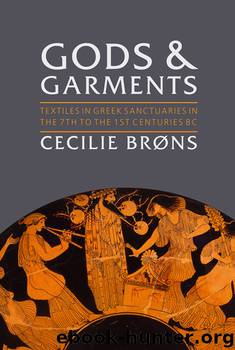Gods and Garments by Brøns Cecilie

Author:Brøns, Cecilie [Неизв.]
Language: eng
Format: epub
ISBN: 9781785703560
Publisher: Casemate Publishers & Book Distributors, LLC
Published: 2016-02-13T21:00:00+00:00
‘(…) to statues which have no use for clothing they consecrate robes (pepli) and costly garments,’77
and Valerius Flacchus writes:
‘Hypsipyle placed her terrified father King Thoas in the quiet temple (of Dionysos) under the feet and right hand of the god; and he remained hidden, received by the sacred garments.’78
Official staff for dressing the cult statues
The act of clothing the cult images was an important responsibility assigned to particular individuals. Many female deities had official wardrobe mistresses, who changed the clothes of images when necessary and appropriate. The dressing and adornment of statues appears – at least at some sanctuaries and cults – to have been managed by officials and subject to regulations, in order to ensure that the practice was correctly observed, as well as to give the impression that images were in need of regular attention and maintenance.79
There were regulations/traditions that determined how the image ought to be dressed and who could perform this task. The latter point was perhaps considered to be especially important, because those who dressed the statue naturally had to remove the previous garment, and would therefore essentially see the image ‘naked’.80 Those responsible for these intimate interactions appear to have been officially categorised in the religious terminology, and in some sanctuaries were called kosmophoroi.81 The term comes from kosmos, which can be translated as ‘adornment’ or ‘adorning’. Another term connected with the official duty of dressing cult statues is the priestly title stolizōn or stolistēs, which can be translated as ‘rober’.82 The word is employed in several inscriptions, e.g. on statues and a herm, all in the Sanctuary of Isis. The majority date to the 2nd century AD.83
There are other related titles in the written record. One is the hypostoloi, who were probably assistants of the stolistes (‘robers’). The term is recorded in two inscriptions from the 3rd century BC and 117 BC.84 Another title for staff that dress a cult statue at Argos is gerairades, who are defined as ‘those who dress the statue of Athena at Argos’.85
The Praxiergidai, who are mentioned in relation to the Sanctuary of Athena on the Athenian Acropolis, are also important in this connection. They were an Athenian clan, whose members were responsible for keeping the statue and its garments clean, that is, washing the statue and its garments, an activity that took place during the Plynteria.86 Members of the Praxiergidai also placed the new peplos upon the statue at the annual Panathenaia.87 There were some cult personnel titles that were probably filled by members of this clan. These include: the Loutrides (‘bather-women’),88 who bathed the statue of Athena; the Plyntrides (‘washer/laundry-women’), who washed the statue’s garments; and probably also the Kataniptēs (‘washer’),89 who likely cleaned and washed the whole statue and its garments throughout the year.90
Download
This site does not store any files on its server. We only index and link to content provided by other sites. Please contact the content providers to delete copyright contents if any and email us, we'll remove relevant links or contents immediately.
On Writing A Memoir of the Craft by Stephen King(4863)
The Doodle Revolution by Sunni Brown(4685)
A Simplified Life by Emily Ley(4097)
Mummy Knew by Lisa James(3630)
Marijuana Grower's Handbook by Ed Rosenthal(3619)
Better Homes and Gardens New Cookbook by Better Homes & Gardens(3524)
Figure Drawing for Artists by Steve Huston(3380)
Paper Parties by Erin Hung(3369)
Draw Your Day by Samantha Dion Baker(3286)
The Genius of Japanese Carpentry by Azby Brown(3223)
Japanese Design by Patricia J. Graham(3108)
The Code Book by Simon Singh(3074)
Dangerous Girls by Haas Abigail(2976)
Lions and Lace by Meagan Mckinney(2922)
The Curated Closet by Anuschka Rees(2912)
How to Make Your Own Soap by Sally Hornsey(2826)
The Checklist Manifesto by Atul Gawande(2776)
The Wardrobe Wakeup by Lois Joy Johnson(2731)
Zero to Make by David Lang(2726)
